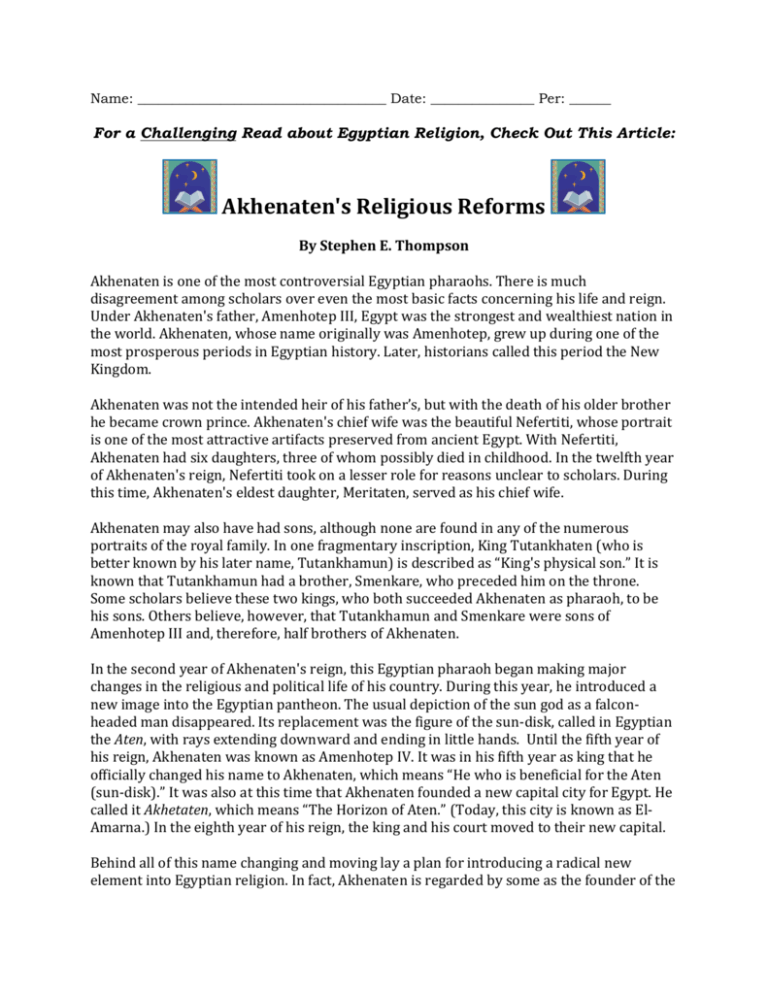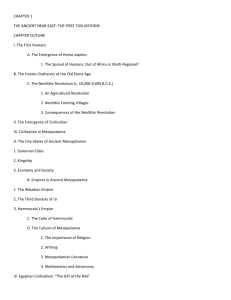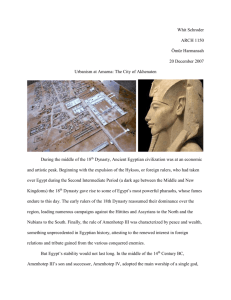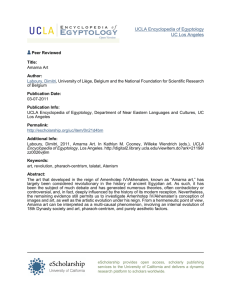Akhenaten`s Religious Reforms
advertisement

Name: ____________________________________ Date: _______________ Per: ______ For a Challenging Read about Egyptian Religion, Check Out This Article: Akhenaten's Religious Reforms By Stephen E. Thompson Akhenaten is one of the most controversial Egyptian pharaohs. There is much disagreement among scholars over even the most basic facts concerning his life and reign. Under Akhenaten's father, Amenhotep III, Egypt was the strongest and wealthiest nation in the world. Akhenaten, whose name originally was Amenhotep, grew up during one of the most prosperous periods in Egyptian history. Later, historians called this period the New Kingdom. Akhenaten was not the intended heir of his father’s, but with the death of his older brother he became crown prince. Akhenaten's chief wife was the beautiful Nefertiti, whose portrait is one of the most attractive artifacts preserved from ancient Egypt. With Nefertiti, Akhenaten had six daughters, three of whom possibly died in childhood. In the twelfth year of Akhenaten's reign, Nefertiti took on a lesser role for reasons unclear to scholars. During this time, Akhenaten's eldest daughter, Meritaten, served as his chief wife. Akhenaten may also have had sons, although none are found in any of the numerous portraits of the royal family. In one fragmentary inscription, King Tutankhaten (who is better known by his later name, Tutankhamun) is described as “King's physical son.” It is known that Tutankhamun had a brother, Smenkare, who preceded him on the throne. Some scholars believe these two kings, who both succeeded Akhenaten as pharaoh, to be his sons. Others believe, however, that Tutankhamun and Smenkare were sons of Amenhotep III and, therefore, half brothers of Akhenaten. In the second year of Akhenaten's reign, this Egyptian pharaoh began making major changes in the religious and political life of his country. During this year, he introduced a new image into the Egyptian pantheon. The usual depiction of the sun god as a falconheaded man disappeared. Its replacement was the figure of the sun-disk, called in Egyptian the Aten, with rays extending downward and ending in little hands. Until the fifth year of his reign, Akhenaten was known as Amenhotep IV. It was in his fifth year as king that he officially changed his name to Akhenaten, which means “He who is beneficial for the Aten (sun-disk).” It was also at this time that Akhenaten founded a new capital city for Egypt. He called it Akhetaten, which means “The Horizon of Aten.” (Today, this city is known as ElAmarna.) In the eighth year of his reign, the king and his court moved to their new capital. Behind all of this name changing and moving lay a plan for introducing a radical new element into Egyptian religion. In fact, Akhenaten is regarded by some as the founder of the first new religion history. Before Akhenaten became pharaoh, the chief god of Egypt's rulers was Amun-Re, a combination of the god Amun and the sun god Re. It was to AmunRe that Akhenaten's predecessors had attributed their success in building Egypt's empire. Many of the spoils of war had gone into the storehouses of Amun-Re's temples. Akhenaten, however, preferred another form of the sun. He chose to worship the Aten, the disk visible in the daytime sky. To prefer to worship one god over the many others worshiped by the Egyptians was not unusual. What was unusual about Akhenaten's belief is that he did not even acknowledge the existence of any other gods. Akhenaten believed that the Aten was the sole god. Because he held this belief, Akhenaten closed down the temples of the other gods. He also sent workers throughout Egypt to remove the name of Amun-Re, and even the word “gods,” from the country's monuments. Aten was the only god officially recognized to exist. In addition, Akhenaten put forth that he was the only one to whom this new god revealed himself. He alone served as the mediator between the Aten and the Egyptians. Individuals worshiped the Aten by praying to an image of the king and his family. In addition to changes in religion, Akhenaten also introduced changes in the Egyptian political administration. For several generations prior to Akhenaten's rule, important government offices had been held by individuals from only a few important families. Akhenaten installed new people of his own choosing into these offices. Akhenaten also allowed Egypt’s diplomatic relations with countries in Asia to deteriorate. The result of these changes was that Egypt's control over its empire in this part of the world had greatly diminished by the end of Akhenaten's reign. Akhenaten's reforms were never very popular with the average Egyptian. In the workers’ village at Akhetaten, archaeologists have discovered prayers to Amun. Upon Akhenaten's death, his religious program was discontinued. His successor, Tutankhamun, eventually reopened the temples of the other gods and moved the capital of Egypt from the Horizon of Aten to the traditional location of Memphis. Akhenaten's religious “reform” had ended. Five Important Ideas: Use complete sentences to answer the questions! 1. Why might Akhenaten’s choice to worship one god instead of many anger the average Egyptian? 2. How does the Ancient Egyptian government’s role in religion compare to the US government’s role in religion?










